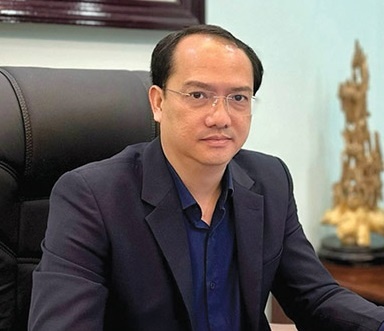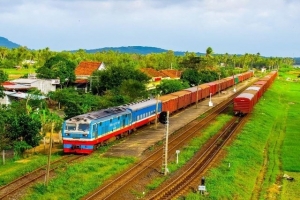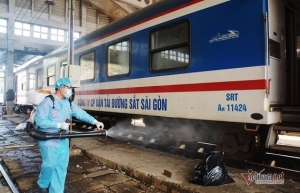Vietnam Railways must open up new development space
With growth momentum in 2023, what are the priorities for Vietnam Railways (VNR) in terms of business strategies to achieve its 2024 targets?
 |
| Deputy general director Tran Anh Tuan |
In 2023, the Vietnamese railway industry overcame many obstacles and achieved a number of important results. VNR’s consolidated revenue surpassed the yearly plan by 1.7 per cent, profit after tax surpassed the plan by 15 per cent, and the average income of employees increased by 5.2 per cent from the yearly plan.
In 2024, the parent company strives for revenues of $263.7 million, rising slightly from 2023. It also aims to increase transport volume by about 7.3 per cent, and after-tax profit by 11.1 per cent on-year to $211 million. The advantage for us this year is that the Commission for the Management of State Capital at Enterprises approved the company’s business plan 2024 in January, three months earlier than last year, thus enabling us to actively implement our plans. In addition, the state-funded maintenance fee of $152.9 million has also been approved and allocated to VNR since the beginning of the year.
To achieve the targets, we have so far this year begun to operate more trains for both long and short routes for the upcoming Lunar New Year. In cargo transportation, we have been more actively working with our partners. We focus on transportation of several items such as coal, minerals, and containers. We plan to open interconnection stations from the Yen Vien station, and upgrade Cao Xa station. VNR has met many partners that want to cooperate with us in transportation of agriculture and seafood items.
We’re also planning to expand its international markets, connecting with China and Europe and with local big industrial parks, for example those in the northern province of Hai Duong. Our unit Ratraco is working with China Railways and localities in China on goods transportation. We also have plans to sign a cooperation contract with shipping giant VIMC, connecting inland container depots (ICDs) at seaports with railway stations and then transporting goods and commodities internationally.
Regarding passenger transport, we are working with big travel companies such as Vietravel on organising multimodel tours by air, railway, and road to diversify tourism products. In March, we will cooperate with Vietravel to open a high-end tour train like the model of a hotel train for tourists who want to attend tourist events in the south-central province of Binh Dinh and its Quy Nhon city. Besides Vietravel, we also cooperate with other travel agents in boosting train routes.
We continue to work with localities in Vietnam like Danang and Thua Thien-Hue to develop tourism trains for them. For example, we will open a tourism train from Hue to Danang in the second quarter of 2024.
Legal barriers still hinder development of the railway industry. What are your expectations about legal improvements to engage private investment, cooperation, and other resources?
We have been facing issues since 2018 because a master plan in line with Decree No.46/2018/ND-CP governing the management and use of railway infrastructure assets has not been solved. Included is VNR’s proposal to hand over about 300 railway stations, warehouses, and ICDs to develop, with assets to be recorded as state capital contribution to the operator, thus enabling it to make investment and do maintenance.
Moreover, land tax is the other big problem facing VNR. At present, we still have to pay tax for the fund for railway production and manufacturing because of unclear regulations. According to the Law on Railway, available land for railway industrial operation is exempted from land tax. However, cities and localities have yet to clarify the kind of such areas in their localities, so that VNR still has to pay land tax. The finance and transport ministries have offered guidelines and documents to amend Decree 46.
We hope that 2024 will bring about improvements for VNR to develop, especially in leasing of railway infrastructure and cooperation with private and international businesses.
At the year-end meeting, the prime minister asked VNR to promote its advantages and new development drivers such as digital transformation and green economy. How can the group tap into them for its sustainable growth?
The railway industry is making efforts to develop and improve passenger service quality, while taking actions to protect the environment. We plan to develop flower routes along railway lines, aiming to develop the longest flower-railway route in the world. We also have a roadmap of investment steps in different periods to contribute to the country’s efforts to fulfil its commitment to net-zero emissions by 2050.
Specifically, we have plans to switch to battery-powered trains, but we need the government’s strong support and huge resources to make this happen.
Along with green growth, the railway industry is working with telecom giants like VNPT and MobiFone on digital transformation. At present, ticket sales are taking place online and can be automated. The parent company’s management over its units and subsidiaries is also being digitalised. We will continue to work with other partners in the upcoming time to accelerate our digital transformation journey.
 | Boosting international railway transport investment The initial successes of the railway container transport network from Vietnam to Europe have provided a fulcrum inspiring the railway sector to increasingly engage with the international network. |
 | National railway investment requiring foreign push Foreign investors are being urged to explore funding railway lines linking seaports as part of the country’s railway development plan – despite high costs, few successful projects, and a lengthy period to see returns. |
What the stars mean:
★ Poor ★ ★ Promising ★★★ Good ★★★★ Very good ★★★★★ Exceptional
Related Contents
Latest News
More News
- Stress laid on high-quality FDI inflows (December 15, 2025 | 11:00)
- Can Tho utilises its growth advantages (December 15, 2025 | 09:09)
- Ca Mau unlocking potential to shape a more sustainable future (December 15, 2025 | 09:02)
- Major projects to be inaugurated nationwide (December 15, 2025 | 08:00)
- MoF workshop highlights mounting concerns over ODA on-lending costs (December 12, 2025 | 16:05)
- National Assembly approves pilot mechanisms to accelerate major projects in Hanoi (December 12, 2025 | 11:29)
- Legislation gives government flexibility for loan guarantees (December 11, 2025 | 18:04)
- Vietnam eases policy approval requirements, simplifies foreign and outbound investments (December 11, 2025 | 17:53)
- Vietnam masters core technologies of automobile value chain (December 11, 2025 | 17:46)
- VAL opens second line of largest soybean crushing complex in Southeast Asia (December 11, 2025 | 12:08)

 Tag:
Tag:




















 Mobile Version
Mobile Version